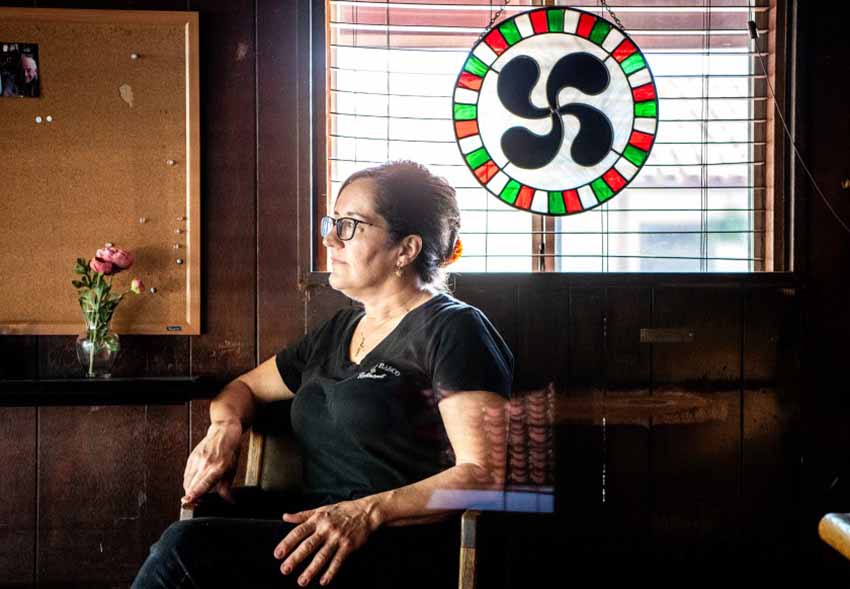Patricia Escárcega. The ongoing COVID-19 pandemic and ensuing shutdown have left many restaurants uncertain about their future. As they grapple with new realities, we asked some of them to share their stories.
This spring, for perhaps the first time in the restaurant’s 80-year-old history, Easter dinner was canceled at Centro Basco.
“I got so many calls from families asking, ‘Are we going to be able to do Basque Easter?’ It was really upsetting to a lot of our old-timers and regulars that it got canceled,” said Bernadette Helton, who operates the restaurant and bar with her brother, Joseph Berterretche.
Before the coronavirus shutdown, family-style dinners and holiday celebrations were a central feature of the historic Basque restaurant and bar in Chino.
Founded in 1940 as a boarding house for Basque immigrants, it has been an important touchstone for Southern California’s small but deep-rooted Basque American community.
Helton estimates there are about a thousand Basque American families left in the Chino area, who until recently still gathered at Centro Basco for parties, holidays and impromptu pelota tournaments on the handball court tucked behind the restaurant.
It also hosted a popular three-course meal known as the Boarder’s Table, which invited guests to sit shoulder to shoulder with strangers around long, wooden communal tables, sharing tureens of beef-onion soup served with sourdough bread; bowls filled with crisp, lightly dressed salads; and platters of classic Basque dishes such as braised oxtail, roast chicken in tomato sauce, and the garlicky pork sausage known as lukinka.
“It’s kind of like Thanksgiving without the drama,” Helton said. “A lot of magic happens around the Boarder’s Table.”
That magic has been foiled by the coronavirus, which threatens family-style dining at places where communal seating and shareable platters are central to tradition but incompatible with coronavirus-era safety measures.
Helton is not sure when Centro Basco will host family-style dinners again, or how long it can keep running on takeout alone. Helton and her brother Joseph, the head cook, have created a daily-changing menu based on staples including grilled lamb, beef tongue, homemade pâté and various vegetable sides.
Takeout is not enough to break even, Helton said, noting that revenue has fallen by 60% since mid-March, and the restaurant’s regulars are anxious to return.
But she is cautious about reopening: Centro Basco’s most faithful patrons are 65 or older, the demographic at higher risk of severe illness if infected with COVID-19.
”People keep asking: ‘When are you opening?’ We don’t know what anything is going to look like yet,” she said.
Centro Basco has square footage on its side: The restaurant has more than 5,000 square feet of dining space across several rooms, making six-feet-apart rules more manageable.
Strangers will no longer be seated together, she said, and that’s a shame.
“I watched strangers become friends around the table. It’s hard to lose that,” she said.
Helton’s parents, Pierre and Monique Berterretche, immigrated from southwestern France, near the old French Basque capital of Saint-Jean-Pied-de-Port, to Wyoming in the mid-1950s before settling in the Chino Valley. After working in dairies for more than a decade, the family saved enough money to buy the restaurant in 1970. They are the fifth Basque family to own Centro Basco, and the family that’s held onto it the longest. Helton’s 89-year-old mother, Monique, still graces the dining room on occasion.
Helton’s childhood memories revolve around the restaurant, which in her lifetime has evolved from a boarding house into a restaurant and bar.
In its early days, Centro Basco was a foothold community for young itinerant workers who immigrated from the mountainous borderlands of northwestern Spain and Southern France and eventually found their way to Southern California.
She remembers the original boarders, mostly young men in their early 20s, who lined up in the dining room promptly at noon and at 7 p.m. daily when Helton’s mother rang the cowbell.
“She was very strict about it. If you weren’t at the table on time, you didn’t eat,” Helton said.
At one point, her mother rented 10 beds to 20 separate boarders.
“There was a day shift and a night shift at the local dairy, and my mom managed to rent every bed twice,” Helton said with a laugh.
Until recently, the restaurant’s old-timers, some wearing traditional Basque berets, gathered around the oak bar after Mass to drink wine, or convened inside the restaurant’s Mus Room to play the card game until sundown.
Centro Basco, and the cultural traditions it sustains, has withstood other disruptions, including the manic growth spurts of the 1980s and 1990s that saw the Inland Valley’s open spaces replaced with housing developments and warehouses.
The restaurant has thrived even in spite of relative obscurity: It’s the oldest restaurant in Chino, yet the two-story white stucco restaurant on Central Avenue is relatively plain and unmarked, except for a faded red awning that reads: “French Basque cooking.”
The sign is meant to enlighten first-time visitors, who sometimes wander into the vast, wood-paneled main dining room, imagining margaritas and baskets of tortillas chips.
“The name can be confusing for some people. Sometimes people come thinking it’s a Mexican restaurant,” said Helton.
For now, Helton dutifully continues to post the takeout menu on the restaurant’s Instagram; at least one old-timer swings by every day for a plate of food.
That’s enough reason to keep the restaurant going, she said.
(published on Los Angeles Times May 29th, 2020)






 Send to a friend
Send to a friend Add comment
Add comment








